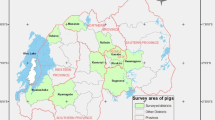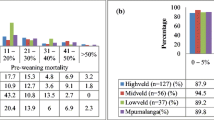Abstract
Free-range pig farming is common amongst the small-scale farmers in western Kenya. In order to determine the characteristics of this type of production system, a cross-sectional questionnaire survey on farm characteristics and management was collected from 182 farmers in Busia District. The mean farm size was one acre, while the mean number of pigs per farm was 3.6. Pigs were mainly kept as a source of income (98%) and majority were of cross breed variety (64%). The production systems included farrow to weaner (12%), porker to finisher (36%), and mixed (46%). Sixty five percent (65%) of the pigs were tethered and housing was not provided in 61% of the farms. Most of the feeds were sourced locally. Lack of castration and delayed weaning of pigs was observed on 49% and 30% of the farms, respectively. The main production constraints included pig diseases (81%) and high cost or lack of feed (81%). Haematopinus suis infestations and worm infections were considered to be the most important diseases by 71% and 55% of the farmers, respectively. Farmers had moderate knowledge on parasitic disease diagnosis with 31% and 62% not having a history of either deworming or spraying pigs with acaricides, respectively. Marketing constraints were common amongst the farmers and included poor prices and inadequate market information. In conclusion, the production system was characterized as low-input with an income objective. Future research and development approaches should focus on the integration of free-range farmers into the country’s market chains through access to extension services.

Similar content being viewed by others
References
Ajala, M.K., Adesehinwa, A.O.K. and Mohammed, A.K., 2007. Characteristics of smallholder pig production in Southern Kaduna area of Kaduna state, Nigeria. American–Eurasian Journal of Agriculture and Environmental Science, 2, 182–187.
Bett, B., Machila, N., Gathura, P.B., McDermott, J.J. and Eisler M.C., 2003. Characterization of shops selling veterinary medicines in a tsetse-infested area of Kenya. Preventive Veterinary Medicine, 632, 29–38.
Chema, S. and Gathuma, J. M., 2004. Kenya: the development of private services and the role of the Kenya Veterinary Association. Revue Scientifique et Technique—Office International des Épizooties, 23, 331–340.
de Fredrick, D.F. and Osborne, H.G., 1977. Pig production in the Solomon Islands. III. The influence of breed, diet and housing on reproduction and growth. Tropical Animal Health and Production, 9, 203–210.
Deca, R., Thorpe, W. M., Lapar, L. and Kumar, A., 2007. Assam’s pig sub-sector: current status, constraints and opportunities. Project Report. ILRI, 2007.
FITCA-K, 2001. Farming in Tsetse Controlled Areas (FITCA-K): Second Annual Progress Report and Financial Statement of Project Activities. March 2000–March 2001.
Gatenby, R.M. and Chemjong, P.B., 1992. Reproduction of pigs in the hills of eastern Nepal. Tropical Animal Health Production, 24, 135–142.
Hide, R., 2003. Pig Husbandry in New Guinea: A Literature Review and Bibliography. Australian Centre for International Agricultural Research, Canberra.
Kagira, J.M., 2001. The prevalence of gastro-intestinal nematodes, control practices and occurrence of anthelmintic resistance in pig herds in Thika District, Kenya. Msc Thesis, University of Nairobi.
Kagira, J.M., Kanyari, P.W.N., Munyua, W.K. and Waruiru, R.M., 2003. The control of parasitic nematodes in commercial piggeries in Kenya as reflected by a questionnaire survey on management practices. Tropical Animal Health Production, 35, 79–84.
Karanja, S.M., 2005. Epidemiology and importance of trypanosomosis, helminthosis and tickborne diseases on performance of cattle in Busia District, Kenya. PhD Thesis. Freie Universitat Berlin.
Lekule, F.P. and Kyvsgaard, N.C., 2003. Improving pig husbandry in tropical resource-poor communities and its potential to reduce risk of porcine cysticercosis. Acta Tropica, 87, 111–117.
Lemke, U. and Zarate, V.A., 2007. Dynamics and development trends of smallholder pig production systems in North Vietnam. Agricultural Systems, 96, 207–223.
Ministry of Finance and National Planning, 2002. Busia District Development Plan 2002–2008. Republic of Kenya.
Ministry of Livestock and Fisheries Development, 2002. Animal Production Division. Annual Report. Republic of Kenya, Government Printers, Nairobi.
More, S.J., Lee, J.A., Lanada, E.B., Taveros, A.A. and Cotiw-an, B.S., 1999. Weight-for-age of growing pigs raised by smallholder farmers in the Philippines. Preventive Veterinary Medicine, 41, 151–169.
Nsoso, S.J., Mosweu, S., Malela, L. and Podis, B., 2000. A survey on population, distribution, management and utilization of indigenous Tswana pigs in Southern Botswana. Animal Genetic Resources Information, 34, 83–96.
Nsoso, S.J., Mannathoko, G.G. and Modise, K., 2006. Monitoring production, health and marketing of indigenous Tswana pigs in Ramotswa village of Botswana. Livestock Research for Rural Development 18, http://www.cipav.org.co/lrrd/.
Permin, A., Yelifari, L., Bloch, P., Steehard, N., Hansen, N.P. and Nansen, P., 1999. Parasites of cross-bred pigs in the upper East region of Ghana. Veterinary Parasitology, 87, 63–71.
Sikasunge C.S., Phiri I.K., Phiri A.M., Dorny P., Siziya S. and Willingham A.L. 3rd., 2006. Risk factors associated with porcine cysticercosis in selected districts of Eastern and Southern provinces of Zambia. Veterinary Parasitology, 143, 59–66.
Taveros, A.A. and More, S.J. 2001. A field trial of the effect of improved piglet management on smallholder sow productivity in the Philippines. Preventive Veterinary Medicine, 49, 235–247.
United Nations Development Program (UNDP) (2008). Human Development Report 2007/2008. United Nations Development Program. New York.
Verhulst, A., 1993. Lessons from field experiences in the development of monogastric animal production. In: Strategies for Sustainable Animal Agriculture in Developing Countries (Mack, S., Ed.). Proceedings of the FAO Expert Consultation held in Rome, Italy, 10/14 December 1990. FAO Animal Production and Health Paper 107, pp. 261–271.
Wabacha, J.K., 2001. A study of factors influencing pig health, productivity, and economics of interventions in smallholder pig farms in Kikuyu Division, Kiambu District, Kenya. PhD. Thesis. University of Nairobi.
Wabacha, J.K., Maribei, J.M., Mulei, C.M., Kyule, M.N., Zessin, K.H. and Oluoch-Kosura, W., 2004. Health and production measures for smallholder pig production in Kikuyu Division, central Kenya. Preventive Veterinary Medicine, 63,197–210.
Acknowledgements
The study was funded by World Bank through the Kenya Agricultural Productivity Program (KAPP). The authors are grateful to cooperation given by participating farmers and extension officers in Busia District, Kenya.
Author information
Authors and Affiliations
Corresponding author
Rights and permissions
About this article
Cite this article
Kagira, J.M., Kanyari, P.W.N., Maingi, N. et al. Characteristics of the smallholder free-range pig production system in western Kenya. Trop Anim Health Prod 42, 865–873 (2010). https://doi.org/10.1007/s11250-009-9500-y
Accepted:
Published:
Issue Date:
DOI: https://doi.org/10.1007/s11250-009-9500-y




